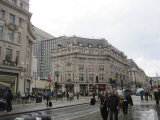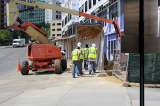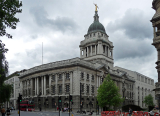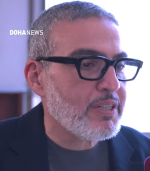UK News
-
UK consumer sentiment remains mixed, says Tesco CEO after Christmas tradingBritish consumer confidence remains uneven, with a widening gap between households that can afford to spend and those under increasing financial pressure, TescoRead More...
-
 Mayor Sadiq Khan brings together new Oxford Street board as regeneration plans gather pace
Mayor of London Sadiq Khan has convened the first meeting of the newly formed Oxford Street Development Corporation (OSDC) Board, marking a major step forwardRead More...
Mayor Sadiq Khan brings together new Oxford Street board as regeneration plans gather pace
Mayor of London Sadiq Khan has convened the first meeting of the newly formed Oxford Street Development Corporation (OSDC) Board, marking a major step forwardRead More... -
 UK’s most dangerous jobs of 2026 — ranking by risk & fatal injury statistics
New data from the Health and Safety Executive (HSE) highlights which occupations in the United Kingdom carry the highest levels of danger for workers, based on fatal injury counts, riskRead More...
UK’s most dangerous jobs of 2026 — ranking by risk & fatal injury statistics
New data from the Health and Safety Executive (HSE) highlights which occupations in the United Kingdom carry the highest levels of danger for workers, based on fatal injury counts, riskRead More... -
 Tesla UK sales slide as Chinese EV makers surge ahead
Tesla’s grip on the UK electric vehicle market weakened sharply in December, with registrations falling more than 29% year-on-year, highlighting mounting pressureRead More...
Tesla UK sales slide as Chinese EV makers surge ahead
Tesla’s grip on the UK electric vehicle market weakened sharply in December, with registrations falling more than 29% year-on-year, highlighting mounting pressureRead More... -
 A turning point for road safety: government unveils plan to cut deaths by two-thirds
A long-awaited reset of Britain’s approach to road safety was unveiled today, with ministers promising a dramatic reduction in deaths and serious injuries on the nation’sRead More...
A turning point for road safety: government unveils plan to cut deaths by two-thirds
A long-awaited reset of Britain’s approach to road safety was unveiled today, with ministers promising a dramatic reduction in deaths and serious injuries on the nation’sRead More...

Culture
-
 Cumbrian animated flood film scoops international science award
A short animated film featuring a red squirrel from Cumbria has won an international education award, shining a global spotlight on how trees can help tackle floodingRead More...
Cumbrian animated flood film scoops international science award
A short animated film featuring a red squirrel from Cumbria has won an international education award, shining a global spotlight on how trees can help tackle floodingRead More... -
 Inside an immersive Guildhall Art Gallery exhibition inspired by the London Tube
The sensory world of the London Tube is brought vividly to life in a new immersive exhibition at Guildhall Art Gallery, uniting painter Jock McFadyen RA with musicianRead More...
Inside an immersive Guildhall Art Gallery exhibition inspired by the London Tube
The sensory world of the London Tube is brought vividly to life in a new immersive exhibition at Guildhall Art Gallery, uniting painter Jock McFadyen RA with musicianRead More... -
 Researchers uncover ‘lost geometric code’ embedded in Oxford and Britain’s historic buildings
Researchers say they have uncovered a long-forgotten geometric code woven into some of Britain’s most famous historic buildings, including landmarks in Oxford.Read More...
Researchers uncover ‘lost geometric code’ embedded in Oxford and Britain’s historic buildings
Researchers say they have uncovered a long-forgotten geometric code woven into some of Britain’s most famous historic buildings, including landmarks in Oxford.Read More... -
 IWM Duxford to open new Second World War rooms revealing unseen artefacts and daily life of wartime pilots
IWM Duxford is set to open three newly restored Second World War spaces, offering visitors an intimate look at the lives of aircrew stationed at the Cambridgeshire airfield during the conflict.Read More...
IWM Duxford to open new Second World War rooms revealing unseen artefacts and daily life of wartime pilots
IWM Duxford is set to open three newly restored Second World War spaces, offering visitors an intimate look at the lives of aircrew stationed at the Cambridgeshire airfield during the conflict.Read More... -
 War-torn Trafalgar Union Flag faces possible departure from UK
A rare Union Flag that led the British charge at the Battle of Trafalgar has been placed under an export bar, giving UK institutions the chance to keep the historic relic in the country.Read More...
War-torn Trafalgar Union Flag faces possible departure from UK
A rare Union Flag that led the British charge at the Battle of Trafalgar has been placed under an export bar, giving UK institutions the chance to keep the historic relic in the country.Read More... -
 Barbican to host Liam Young’s first UK solo exhibition in 2026
The Barbican has announced ‘In Other Worlds’, the first UK solo exhibition by artist, director and BAFTA-nominated producer Liam Young. Opening May 2026, the immersive show will exploreRead More...
Barbican to host Liam Young’s first UK solo exhibition in 2026
The Barbican has announced ‘In Other Worlds’, the first UK solo exhibition by artist, director and BAFTA-nominated producer Liam Young. Opening May 2026, the immersive show will exploreRead More... -
 The Manchester Museum displays thousands of African artefacts it knows little about
A museum in northwest England has unveiled a new gallery showcasing thousands of African artefacts, many of which the institution admits it knows very little about. The exhibition aims toRead More...
The Manchester Museum displays thousands of African artefacts it knows little about
A museum in northwest England has unveiled a new gallery showcasing thousands of African artefacts, many of which the institution admits it knows very little about. The exhibition aims toRead More... -
 Captain John Narbrough’s journal faces export ban amid fears it could leave the UK
A rare 17th-century manuscript journal documenting Captain John Narbrough’s secret expedition to Spanish America and the Pacific has been placed under a temporary export ban, giving UKRead More...
Captain John Narbrough’s journal faces export ban amid fears it could leave the UK
A rare 17th-century manuscript journal documenting Captain John Narbrough’s secret expedition to Spanish America and the Pacific has been placed under a temporary export ban, giving UKRead More... -
 Earliest evidence of human fire-making unearthed in Suffolk
A team led by the British Museum has uncovered what is now the earliest known evidence of humans deliberately making fire—dating back around 400,000 years—at a site in Barnham,Read More...
Earliest evidence of human fire-making unearthed in Suffolk
A team led by the British Museum has uncovered what is now the earliest known evidence of humans deliberately making fire—dating back around 400,000 years—at a site in Barnham,Read More... -
 Rothschild 15th-century prayer book set to fetch up to $7 million at Sotheby’s auction
Ultra-rare 15th-century mahzor features vivid medieval illustrationsRead More...
Rothschild 15th-century prayer book set to fetch up to $7 million at Sotheby’s auction
Ultra-rare 15th-century mahzor features vivid medieval illustrationsRead More... -
 Ray Winstone honoured with Freedom of the City of London
Ray Winstone, one of the UK’s most celebrated ‘hard man’ actors, has been awarded the Freedom of the City of London in recognition of his extensive charitable and fundraising work.Read More...
Ray Winstone honoured with Freedom of the City of London
Ray Winstone, one of the UK’s most celebrated ‘hard man’ actors, has been awarded the Freedom of the City of London in recognition of his extensive charitable and fundraising work.Read More... -
 Golden Globe 2026 nominations announced ahead of January ceremony
The nominations for the 83rd annual Golden Globe Awards were unveiled on Monday, setting the stage for the first major awards ceremony of the season on January 11.Read More...
Golden Globe 2026 nominations announced ahead of January ceremony
The nominations for the 83rd annual Golden Globe Awards were unveiled on Monday, setting the stage for the first major awards ceremony of the season on January 11.Read More...

British Queen celebrates
Most Read
- Teen held after US woman killed in London stabbings
- Heave-ho Harry! Prince prepares to join the walking wounded in ice trek to North Pole
- Football: Farhad Moshiri adamant Everton deal above board
- "Master of English Style". Interview with Designer Lydia Dart
- Letter to the Financial Times from Lord Mayor Alderman Michael Bear
World News

To celebrate St. Patrick's Day, King Charles III sent a special message to President Michael D. Higgins of Ireland. The King conveyed his warmest congratulations to the President and

HSBC, the new owner of Silicon Valley Bank UK, has approved millions of pounds in employee bonuses just days after the bank was rescued from insolvency by the Bank of England.

On March 18, British Interior Minister Suella Braverman visited Rwanda to discuss the country’s acceptance of migrants who arrive in the UK without permission. This is part of a £120m deal

SVB Financial Group has filed for Chapter 11 bankruptcy protection to seek buyers for its assets, following the recent takeover of its former unit, Silicon Valley Bank, by US regulators.

Israeli Prime Minister Benjamin Netanyahu is scheduled to visit London for an official visit next week, according to an announcement made by his office on Friday. The trip, which is expected to

In a show of deepening defense ties, Britain and Japan have agreed to collaborate on space initiatives. The agreement was reached on Friday and follows the two countries' partnership on the

First Republic Bank has received a $30 billion lifeline from large US banks to quell concerns of a banking collapse following the collapse of two other mid-sized US lenders in the past week.

Inflation in Argentina has soared past 100% for the first time since 1991, with prices more than doubling since February last year. According to recent reports, prices last month were 102.5%

According to a recent study published by the Swiss federal technology institute ETH Zurich's Military Academy and Centre for Security Studies, 55% of Swiss citizens surveyed now express a

According to the Labor Department, initial claims for state unemployment benefits decreased by 20,000 to a seasonally adjusted 192,000 in the week ending March 11. This figure is lower than






















